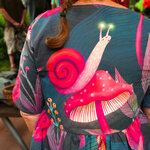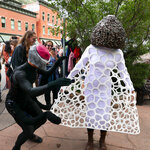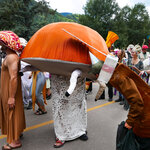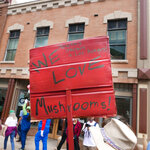






WHAT KIND OF WIERD THING on earth is a Mushroom Festival one might ask? Well, there are Garlic Festivals, Apple Festivals and Tulip Festivals, so why not one for mushrooms?
Mind you, it is not just a gathering of hippies and alternative medicine people. Rather it has been going on for 42 years and this year attracted more than 800 people from all over the world, from Siberia to Florida to Chile. It brings together serious scientists from Nobel Prize laureates to doctors, chemists, writers, businesspeople and various other professionals.
Many of the attendees represent decades in mycology (the study of mushrooms) and want to try to make the world a better place through the use and scientific study of fungi.
Its roots lie in 1981, when Beth Israel Hospital hosted a conference in Aspen, focusing on the clinical treatment of mushroom poisonings. Following this, mycologists such Gary Lincoff, author of the Audobon Guide to North American Mushrooms, Paul Stamets, owner of the large Oregon-based company “Fungi Perfecti” and Manny Salzman, a radiologist and expert on mushroom poisonings, decided to organize a regular mycology event deep in southwestern Colorado.
Of course, they also liked to party together, but that was not the main idea behind their efforts. The study of mushrooms does, after all, lend itself to good food, fermented beverages and sometimes some psychoactive fungi thrown into the mix, right?
Telluride, Colorado is a charming historic mining town locked into a panoramic box canyon surrounded on three sides by towering mountains. Telluride is also very close to lots of high-elevation forests and meadows which are easily (or difficultly) accessible by interesting, and sometimes rather challenging, dirt logging roads. They may be rocky, bouncy, twisty and turny, with the occasional sheer cliff thrown in, but they’ll get you there.
This southwestern part of the state also receives late summer monsoon rains which activate fungal production. The elevations are quite high, from around 9,000 to 11,500 feet and filled with gigantic panoramas of mountain vistas that never seem to end. Those elevations often get one above the aspen tree zone and into pure spruce and fir forests, trees that have unique relationships with a specific variety of fungi.
With phrases like, “Mushrooms have the potential to revolutionize our relationship with the world and ourselves,” this year’s festival saw an assemblage of therapists, forest pathologists, edible fungi cultivators, polluted habitat restorers, DNA analysts, taxonomists, brewers, journalists, chefs, photographers, artists and vendors.
A wide range of topics were lectured on, not the least of which was the currently popular topic of Psilocybe mushrooms and their increasing use in psychotherapy for people suffering from all sorts of ailments, from PTSD to end-of-life care, fighting addiction, treatment-resistant depression and chronic pain.
There were lectures on everything else, including sequencing DNA, myco-remediation (using fungi to decompose polluted lands), mushroom cultivation, the use of microscopes in taxonomy, identification of mushrooms of the Rocky Mountain region, cultivating medicinal mushrooms, cooking demonstrations, myco-technologies (such as making paper, packaging material and structural building elements from mycelium), analysis of the genome of the Porcini family, fungal spore release mechanisms, conservation of trees and fungi in the Amazonian rainforest and hunting fungi in the Himalayan mountains.
From Russia, there was a presentation on a well-researched new book coming out about the medicinal applications of Amanita muscaria, the famous red mushroom with white dots, including micro-dosing and topical pain relief treatments. This was based on studies done in Siberia with over 3,000 participants. It is the first time a serious book from Russia has been written concerning the medicinal use of very small doses of this powerful hallucinogenic either internally, or as a topical cream for pain. In fact, this mushroom has been used and experimented with for a variety of medicinal purposes for centuries in the region of Siberia.
On a lighter note, there were forums on cooking with mushrooms (mycophagy”) of which I was a participant, and on every day of the five-day event at least four different guided walks in the mountains were offered by local experts. There was also the annual Poetry Slam with theater, very creative performances, poetry and song along with a bar serving myco-beers, and mushroom-based beverages. Finally, on Saturday afternoon, the annual mushroom parade was held. Each year an award is granted for the best costume.
This year a giant porcini won the prize complete with a few fabric worms hanging off of his cap. There were also entertaining costumes such as the Stinkhorn lady with her accompanying companion, a black fly circling around her. There were various Chanterelle Ladies, Ganoderma men (mostly just with funny hats), and the parade ended in a giant drumming circle that went on late into the evening and various dinner parties ensued, scattered throughout town. So why did I go to this obscure, odd and interesting event? Well, for me, it’s primarily about collecting the huge fruitings of Colorado’s Porcini harvest, which mycologists correctly say yields the best-tasting Porcinis in North America.
Last year I returned with more than two dozen gallons dried Porcinis. This year, only one. But hey, the mushroom harvest always varies due to weather and the comradery with other mycologists and the joy of the hunt is what brings many participants.
As they say in the fishing world, “it’s called fishing, not catching.” So, I attend for the joy of the hunt, the sharing of information and scientific curiosity, and to enjoy the sheer magnificence of the state of Colorado. And to my mind, those are some pretty good reasons.
Gary Gilbert lectures on fungi, leads mushroom walks and is a member of the Boston Mycological Club and is the author of “Mycocards,” flashcards for learning.